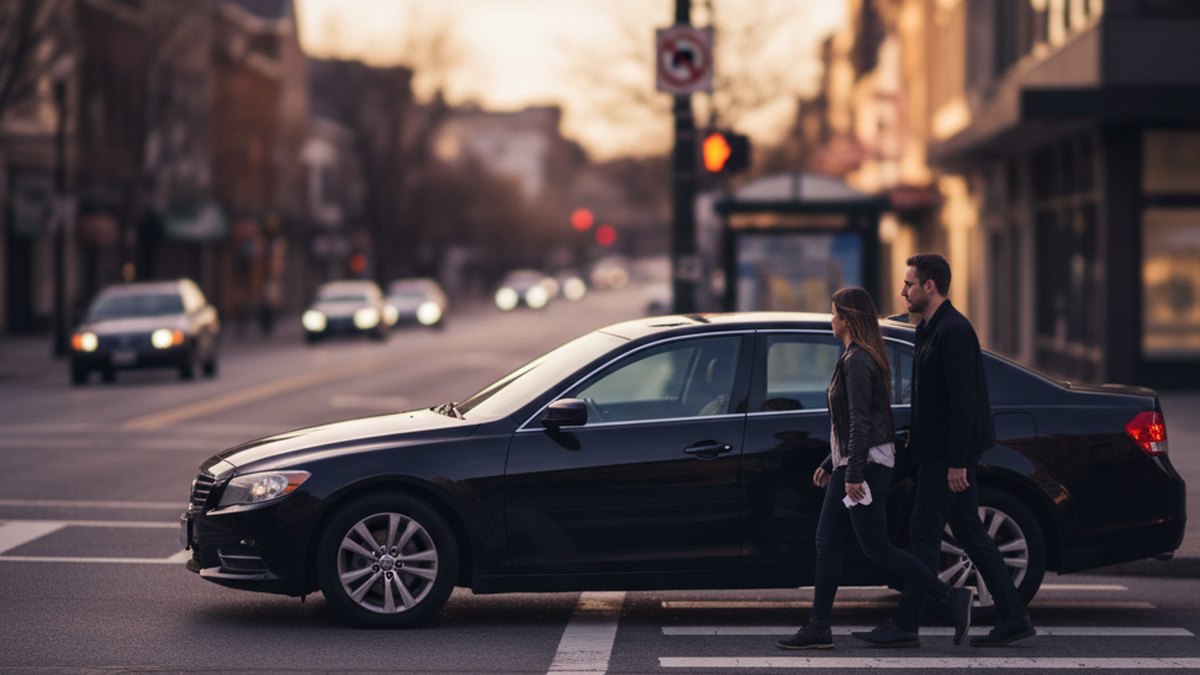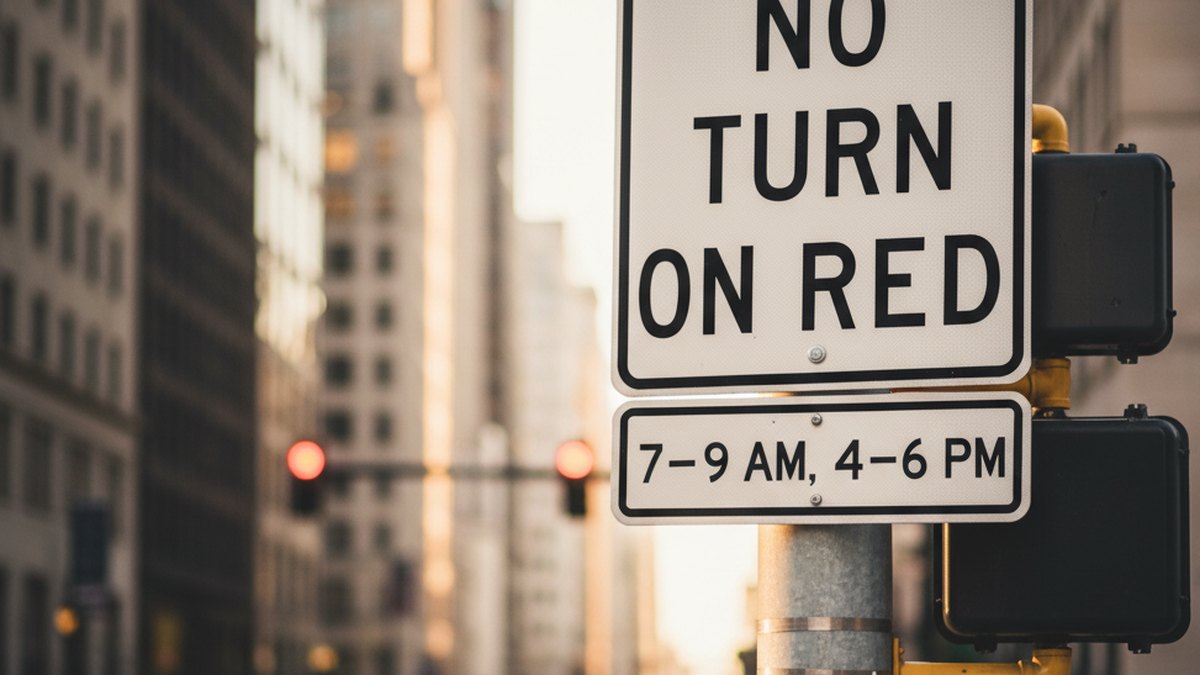Right Turn on Red: Rules, Signs & Exceptions
Complete guide to right turn on red laws across all 50 states: required full stop procedures, NO TURN ON RED sign meanings, pedestrian right-of-way rules, red arrow signals, and camera enforcement.

You must make a complete stop before turning right on red
In every U.S. state that allows a right turn on red, the first rule is non-negotiable: make a complete stop at the limit line, crosswalk, or intersection entrance. Rolling a few inches, coasting, or "California rolling stop" does not count. Treat the red light like a stop sign: stop, look, and yield. Scan left for cross-traffic with the right-of-way, scan ahead for vehicles turning left on a green arrow, then scan right for pedestrians and cyclists who may be stepping into the crosswalk on a WALK signal.
After the full stop, proceed only when the path is clear and there is no sign or signal that prohibits the movement. If sight lines are blocked by large vehicles, poles, or landscaping, inch forward to the edge of the crosswalk without entering it. Your wheels should remain straight until you are certain to go—turning them early invites a rear-end push into cross-traffic.
Reading "NO TURN ON RED" and time-based signs

A posted NO TURN ON RED sign overrides the default permission to turn after stopping. Many cities use time-based restrictions near schools, transit corridors, or high-crash intersections. Read the entire panel: "NO TURN ON RED 7–9 AM, 4–6 PM" means a right turn on red is legal outside those hours but not during them. Some signals add a red arrow; a steady red arrow is a do-not-turn indication unless a sign explicitly allows it.
School hours, arrows, and flashing signals
Near schools, restrictions often align with pick-up/drop-off windows. When school is not in session, the restriction may not apply—but signs vary by jurisdiction, so rely on the exact wording. A flashing red acts like a stop sign: stop, then proceed when safe. A flashing yellow arrow allows a cautious turn but does not negate yielding duties.
Pedestrian and cyclist right-of-way priorities
People walking or riding through the crosswalk on a WALK signal have priority. Drivers must yield even if they have already stopped and are waiting to turn. Watch for leading pedestrian intervals (LPI), where the WALK appears a few seconds before parallel traffic gets a green—LPIs are designed to make pedestrians visible and give them a head start. Expect riders on protected bike lanes to continue straight on a green; they have priority across your turn path.
Red-light camera enforcement pitfalls
Automated cameras frequently capture rolling stops on right-on-red turns. Tickets often show multiple frames: your vehicle before the stop line, then during the turn. If your wheels never fully stopped, the violation is typically clear. Even with a full stop, entering against a posted restriction, entering the crosswalk while people are present, or failing to yield to cyclists can also trigger citations.
When a right turn on red is outright banned
Some jurisdictions ban right turns on red at selected corridors—or citywide in special zones—to protect vulnerable road users and reduce conflicts. You'll see this most often in downtown grids with heavy foot traffic, near schools, and where protected bike lanes intersect with right-turn lanes. A steady red arrow also bans the turn unless a sign allows it; treat the red arrow as the functional equivalent of a "NO TURN ON RED."
Remember that local rules vary. Even within the same state, a city may deploy broader restrictions than the state driver manual suggests. That's why reading the signal face and any supplemental plaques is critical. If signage conflicts with a generic rule of thumb, the sign wins.
Practical right-on-red technique: safe scanning and clean execution
Good technique makes right-on-red smooth and citation-proof. Approach in the rightmost lane, signal at least 100 ft in advance, and glide to a controlled full stop behind the limit line. While stopped, run a scan pattern: left → ahead → right → mirrors → blind spot. Confirm that no NO TURN ON RED is posted, then choose a gap that doesn't force through traffic or people in the crosswalk to brake.
Keep the steering wheel straight until the moment you commit. If a vehicle rear-ends you while you're angled, your car can be shoved into the intersection. Finally, turn into the nearest available lane unless signs permit otherwise; swinging wide across multiple lanes can block drivers with a green and often violates lane-use laws.
Special cases: red arrows, dual right-turn lanes, and protected bike lanes
Red arrows vs. circular reds
A circular red controls all movements in that signal face; a steady red arrow specifically bans the turn in the arrow direction. Unless an explicit sign allows it, do not turn on a steady red arrow. A flashing red arrow functions like a stop sign for that movement.
Dual right-turn lanes and channelized islands
With two right-turn lanes, both drivers must stop fully and choose the correct lane on entry. Stay in your lane through the turn; late merges across lanes cause sideswipe crashes and right-of-way confusion. Channelized right-turn islands may have their own signal: a steady red at the island requires the same complete stop and yield.
Protected bike lanes and leading ped intervals
Expect straight-through cyclists to continue on a green while you face a red. Yield completely until the bike lane is clear. Where LPIs are used, pedestrians start walking first; build the habit of re-checking the crosswalk after your initial left-ahead-right scan—someone may have stepped off the curb while you looked away.
Related Articles
Pedestrian Priority at Crosswalks
Understand when and how to yield to pedestrians in marked and unmarked crosswalks.
Left on Red (One-Way to One-Way)
Learn when left turns on red are permitted from one one-way street to another.
Right-of-Way at Roundabouts
Master the yielding rules and lane selection at modern roundabouts.
State-Specific Traffic Laws
Browse traffic laws and regulations for all 50 U.S. states.